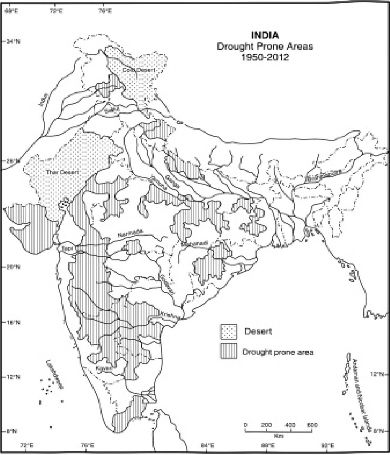DROUGHTS
Drought is a continuous and lengthy period during which no significant rainfall is recorded. In India, the Meteorological Department of India defined drought as a period of at least 22 consecutive days on none of which is there more than 0.25 mm (0.01 inch) of rainfall. This definition however, does not apply to the whole of India. In areas like Mawsynram and Cherrapunji (recording over 1200 cm of average annual rainfall) even one week recording less than 0.25 mm of rainfall may be considered as a drought period. In general, the areas recording less than 60 cm of rainfall annually and in which the variability of rainfall is more than 20 per cent are the drought prone areas in India. Areas where the variability of rainfall varies between 20 to 60 per cent (like Rajasthan, west of Aravallis, and east of the Western Ghats) are the chronic drought prone areas. In India, droughts are more frequent in the areas where the average annual rainfall is less than 60 cm and the variability of rainfall is over 20 per cent, provided canal and tube-well irrigation is not available. The variability of rainfall over greater parts of the country is more than 25 per cent, and thus over 50 per cent of the country is vulnerable to droughts.
According to the Ministry of Agriculture and the Ministry of Environment, a drought prone area is defined as one in which the probability of a drought year is greater than 20 per cent. A chronic drought prone area is one in which the probability of a drought year is greater than 40 per cent. A drought year occurs when less than 75 per cent of the average annual rainfall is recorded.
On an average, one in every live years is a drought year in India, while in western Rajasthan every third year is a drought year. Although over 60 per cent of the area has high variability of rainfall, there are three areas which are highly vulnerable to droughts (Fig. 4.25). The drought prone areas of India are:
1. The Arid and Semi-arid Areas of Rajasthan: There is a contiguous region, covering greater parts of northern Gujarat, Rajasthan, south-west Haryana, southern parts of Punjab, western Madhya Pradesh, and parts of the Agra Division of Uttar Pradesh. This drought prone area, having a variability of rainfall of over 40 per cent, stretches over 65 lakh sq km. Parts of these contiguous drought prone areas, irrigated by canals and tube-wells are, however, less affected by droughts.
2. The Rain-shadow Areas of Western Ghats: This is the area lying to the east of the Western Ghats (Sahyadri Mts), stretching from J algaon (Mahrashtra) to Hyderabad and Mahbubnagar (Andhra Pradesh), Bidar, Bijapur, Gulbarga, and Raichur of Karnataka, ami Coimbatore, Madurai, Salem and Reman athapuram of Tamil Nadu. The variability of rainfall in this region varies between 30 to 40 per cent. It is in this areas that several thousand farmers have committed suicide during the last decade.
3, Other Drought Prone Areas* There are isolated tracts.
legion oFOdisha, Purulia District of West Bengal. Falamu plateau ofjharkhand, Miizapur Plateau, and Bundelkhand (IIP.), Baghelkhand (Madhya Pradesh), Coimbatore, Madurai and Tirunelveli District of Tamil Nadu. These scattered pockets cover over one lakh sq km.

Fig. 4.25 □ rang ht Prone Areas (1950-2012)
Though droughts are recurring physical phenomena and their severity was more during the medieval period, some of the serious droughts of the 20th century have been briefly described in the following section:
The Maharashtra drought of 1965-66, the Bihar drought of 1966-67, the Kalahandi drought of 1996-97 and the continuous deficient rainfall in Andhra Pradesh, Karnataka and western Tamil Nadu during the last decade forced a number of the farmers to commit suicide, The monsoon failure in. 2009 over greater parts of the country resulted into drought. Consequently the Kharif cropped area decreased by about 40 per cent.
The adverse effects of droughts can be minimised by an extension in the irrigation projects, adoption of sprinkle irrigation, water harvesting, suitable rotation of crops, deviation from the more water requiring crops, and dry-farming techniques. If all these steps are taken together, the miseries of the farmers and inhabitants of the drought prone areas may be reduced substantially.
Droughts are disasters which affect the people and economy of the country adversely. Their frequency, according to experts of climatology, is likely to increase in future due to greenhouse gases, climatic change and ecological imbalances created by interference of man.
The years of 196.5-67, 1972 73, 1979-80, 1985 88, 1999, 2000, 2001, 2002 and 2009 have been the drought years in India after Independence. According to the experts the drought of 2002 and 2009 was one of the worst droughts in the last one hundred years. In these years, the states of Haryana, Punjab, Uttar Pradesh, Uttarakhand, Bihar, Madhya Pradesh, Gujarat, Tamil Nadu, Karnataka, Jharkhand, Odisha, parts of Kerala, and the whole state of Rajasthan were the worst affected.
